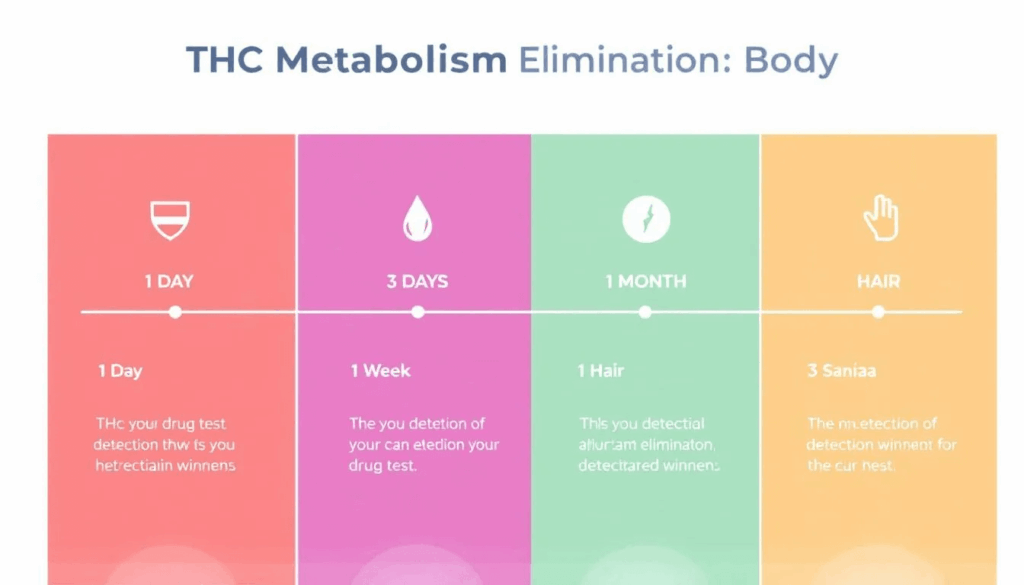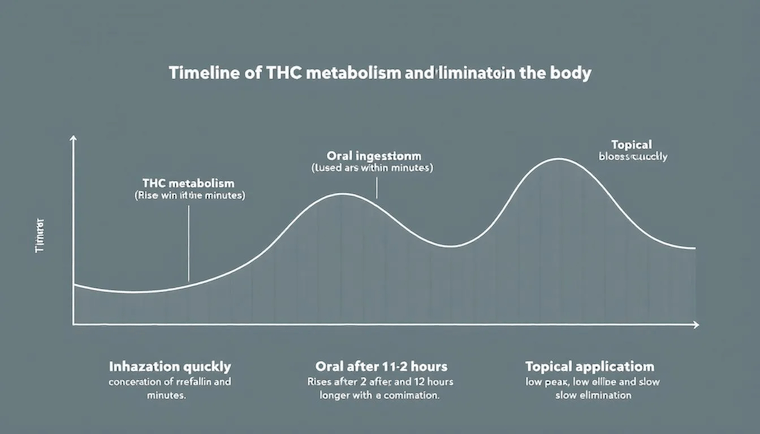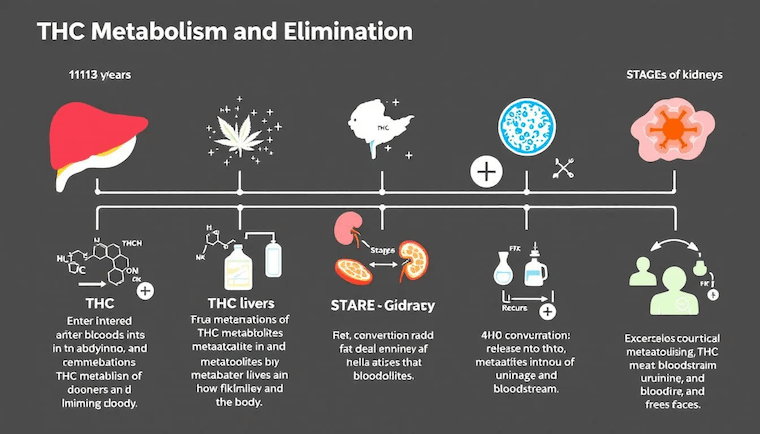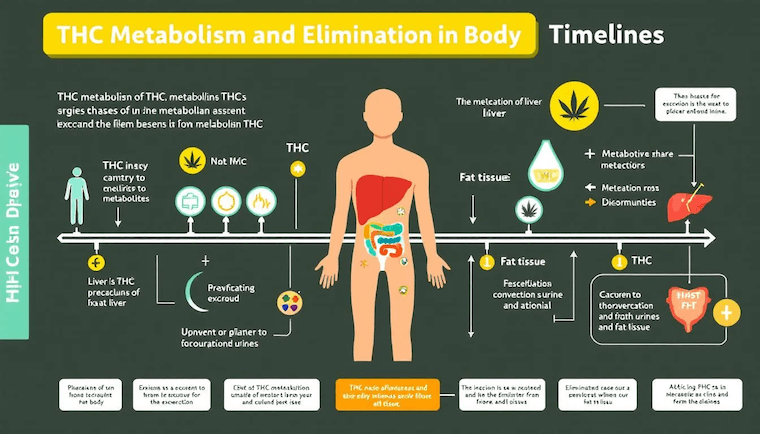How long does weed stay in your system after quitting? For occasional users, THC can be detectable for up to 5 days. Regular users might have it stay for weeks or even months. In this article, we will delve into the factors that influence how long does weed stay in system after quitting, helping you understand what to expect.
Key Takeaways
- THC retention in the body varies significantly based on factors such as frequency of use, body fat percentage, and metabolism speed.
- Detection windows for THC vary by the type of drug test, with urine tests showing the longest detection times, particularly for chronic users.
- Common myths about detox methods suggest that drinking excessive water or using detox kits can hasten THC elimination, but these methods often lack efficacy and consistency.
Factors Affecting THC Retention

Understanding how long weed stays in your system involves considering several factors:
- Frequency of marijuana use
- Body fat percentage
- Metabolism speed
- Genetics, which influence how quickly the body can metabolize and eliminate THC Each element significantly influences THC retention, making it essential to consider these variables.
Frequency of Marijuana Use
One of the most significant factors affecting THC retention is the frequency of marijuana use. Occasional users may find that THC metabolites stay in their system for approximately 3-5 days. In contrast, chronic users could see detection windows extending up to 30 days or even longer. The cumulative effects of marijuana lead to prolonged detectability in regular users. Long does weed stay is a common question among those curious about THC retention.
Understanding these differences in detection windows can inform users about potential implications for testing and personal circumstances. For instance, someone who uses marijuana daily will have a much longer detection window compared to someone who uses it occasionally. This knowledge is crucial for those who need to plan around drug tests or are considering quitting.
Body Fat Percentage
Body fat percentage is another critical factor regarding THC retention:
- THC is fat-soluble and binds to fat molecules.
- This binding leads to longer retention in individuals with higher body fat.
- Therefore, those with higher body fat percentages can expect THC to remain in their system for a more extended period, especially in those with more fatty tissue.
On the other hand, individuals with lower body fat percentages might eliminate THC more quickly. This suggests a difference in how body composition affects THC clearance.
Metabolism Speed
Metabolism speed also plays a vital role in THC retention. A faster metabolism results in quicker elimination of THC and its metabolites. Factors such as individual metabolic rates, age, and overall wellness can influence the speed of THC metabolism.
Individuals with lower body fat may metabolize and clear THC more efficiently.
Detection Windows for Different Drug Tests

Detection windows for drug tests vary based on the type of test and the method of consumption. Urine drug tests, blood, saliva, and hair follicle tests each have different detection windows, influenced by the frequency of use and the consumption method.
Knowing these windows can help you understand how long THC metabolites remain detectable in your system.
Urine Tests
Urine tests are the most common method for detecting marijuana use due to their longer detection window compared to other tests. Detection times for THC vary based on usage frequency:
- Occasional users: THC detectable for approximately 3-5 days (varies by individual factors)
- Regular or heavy users: THC detectable for several weeks or up to 30 days or longer
- Chronic users: THC detectable for up to 70 days in some cases. Long does weed affect how long THC remains in the system.
The frequency of use and dosage both influence the detection time of cannabis metabolites. Employers often require drug tests for new hires or randomly for current employees, making it essential to understand how long THC stays in your system based on your usage patterns.
Blood Tests
Blood tests can detect marijuana for up to 36 hours for most users, but this window can extend up to seven days for chronic users. Blood tests are less common for marijuana detection because THC levels decrease quickly in the blood.
The method of consumption also affects THC retention in the blood, with smoking yielding shorter detection periods compared to other methods.
Saliva Tests
Saliva tests are effective for detecting recent THC use. Key points about saliva tests include:
- For frequent smokers, THC can be detected in saliva for up to 72 hours.
- A saliva test uses a mouth swab to absorb THC from saliva.
- This method makes them particularly useful for detecting marijuana shortly after use.
Hair Follicle Tests
Hair follicle tests can detect marijuana use for up to three months after consumption. This method provides insights into past consumption and can potentially track THC metabolites for even longer.
Hair follicle tests are reliable for assessing long-term hair tests marijuana use.
Impact of Consumption Methods

The method of marijuana consumption significantly impacts THC retention. Whether you smoke, vape, or consume edibles, each method affects how quickly THC is absorbed and how long it stays in your system.
Understanding these differences can help you better manage your marijuana use and its detection.
Smoking and Vaping
Smoking and vaping cannabis typically lead to quicker absorption of THC into the bloodstream compared to other methods. The rate at which THC reaches the bloodstream after inhalation is within minutes, leading to quicker onset of effects from smoking marijuana.
This rapid absorption also means that THC metabolites may be detectable sooner after use.
Edibles and Other Ingestibles
Consuming cannabis through edibles results in a slower onset of effects and prolonged retention of THC in the body. The digestion process for edibles can extend the time THC remains in the system, leading to longer detection periods.
This slower metabolic absorption process means that THC stays in your system longer compared to smoking or vaping.
Role of Hydration and Diet
Hydration and diet play crucial roles in THC elimination. While staying hydrated can help flush THC metabolites faster, maintaining a nutrient-rich diet supports liver health, which is essential for THC metabolism and detoxification.
These factors and other factors can aid in the natural detox process, although they may not drastically speed up THC elimination.
Importance of Hydration
Drinking plenty of water can help increase urine production, aiding in the removal of THC metabolites. Staying hydrated facilitates the clearance of these metabolites from the body, making hydration a vital component of THC elimination.
However, it’s important to note that hydration alone won’t significantly speed up the removal of THC from fat cells.
Dietary Influences
A balanced diet is essential for supporting the body’s natural detoxification process. It helps maintain overall health and well-being. Nutrient-rich foods improve liver health, enhancing THC metabolism and detoxification. Common ingredients in detox kits, such as herbal supplements like ginseng and milk thistle, detox supplements are believed to support liver function, although their efficacy varies.
Maintaining a healthy liver is crucial for efficient THC elimination.
Exercise and Physical Activity
Regular physical activity can enhance the body’s ability to metabolize and eliminate THC, a crucial body process THC involving a psychoactive compound. Exercise boosts metabolism, helping to deplete THC stored in body fat.
Engaging in physical activities that increase heart rate and promote sweating can assist in the faster elimination of THC.
Boosting Metabolism
Consistent physical activity can elevate metabolic rates, aiding in breaking down THC stored in fat. Routine exercise significantly raises the metabolic rate, promoting the burning of fat and thereby releasing stored THC into the bloodstream for elimination.
Types of Effective Exercises
Incorporating cardiovascular exercises such as running or cycling can enhance THC clearance by increasing physical activity levels. Engaging in a mix of aerobic and strength training exercises not only aids in THC elimination but also promotes overall physical health.
High-intensity interval training (HIIT) is particularly effective in boosting metabolism and promoting fat loss.
Detox Methods and Myths

There are numerous detox methods and myths surrounding THC elimination. Quitting marijuana use is the only dependable method to pass a drug test. While some detox kits claim to cleanse THC from the body, they usually only provide temporary solutions.
Understanding the effectiveness of these methods is crucial for making informed decisions.
Detox Kits and Supplements
Detox kits are often used by individuals aiming to eliminate THC faster from their system. These kits claim to help users pass drug tests by temporarily masking THC presence. However, the effectiveness of detox kits is often questioned, with many users reporting limited results.
While detox kits may provide some relief, professional care ensures a structured recovery approach for marijuana addiction.
Common Myths
There are several common myths about THC detoxification. Drinking large amounts of water won’t significantly speed up the removal of THC and can dilute urine, resulting in inconclusive test outcomes. No detox product can guarantee quick elimination of THC; the body’s natural detoxification rate is influenced by individual metabolic rates and frequency of use.
It’s also commonly assumed that exercising before a drug test can help eliminate THC, but this could potentially release stored THC back into the bloodstream.
Secondhand Marijuana Smoke
Secondhand marijuana smoke can potentially expose individuals to THC, raising questions about its impact on drug testing. While the likelihood of leading to a positive drug test is generally low, it is advisable to reduce exposure to ensure reliable drug testing results.
Risk of Positive Test
Secondhand marijuana smoke can lead to exposure to THC, which raises concerns about testing positive. The likelihood of testing positive from secondhand smoke depends on factors such as the amount of smoke exposure and the sensitivity of the test used, particularly in light of recent marijuana trends.
Drug tests primarily look for THC metabolites to detect thc metabolites, which can linger in the body after exposure. False positives can occur due to cross-reactivity with other substances, making confirmatory tests essential to ensure accurate results.
Potential for False Positives
False positives in drug tests can occur due to various reasons. Exposure to secondhand marijuana smoke can result in small amounts of THC being detected in the body, particularly after prolonged exposure. Scientific studies have not shown that casual exposure to secondhand marijuana smoke can lead to a positive drug test.
Confirmatory tests play a crucial role in verifying results. They help ensure the accuracy of the findings.
Causes of False Positives
Certain drugs like efavirenz and some proton pump inhibitors are associated with false positives for THC in drug tests. To potentially test positive from secondhand smoke, a person would need significant and prolonged exposure to the smoke.
Extended contact in poorly ventilated areas increases the chances of testing positive from secondhand marijuana smoke.
Confirmatory Testing
Confirmatory tests play a crucial role in ensuring that drug test results are accurate and reliable. These tests can differentiate between THC and other substances that may show similar results, providing a clear drug screen.
Mass spectrometry can analyze the molecular weight of substances to identify them accurately during confirmatory testing.
Marijuana Addiction and Treatment Options

Marijuana addiction, known as marijuana use disorder, affects a significant number of users. Approximately 30% of marijuana users develop a use disorder, with those starting before age 18 being 4 to 7 times more likely to develop a weed addiction. Cannabis use is a factor that can contribute to these statistics, and drug abuse can also play a role in these outcomes. Additionally, weed use can influence the likelihood of developing these issues.
Understanding the signs of addiction and available treatment options is crucial for those seeking help.
Recognizing Marijuana Use Disorder
Common signs of marijuana use disorder include cravings, increased tolerance, and withdrawal symptoms. If an individual experiences significant impairment or distress due to their marijuana use, it may be time to seek help.
Recognizing these signs early can lead to more effective intervention and treatment, helping individuals regain control over their lives.
Treatment Programs
American Addiction Centers offer various treatment options for marijuana addiction treatment, including residential treatment and outpatient programs. Evidence-based treatments such as cognitive-behavioral therapy, motivational enhancement therapy, and behavioral therapy have proven effective in addressing marijuana use disorder.
Inpatient treatment programs provide a structured environment essential for recovery.
Summary
In summary, multiple factors influence THC retention in the body, including frequency of use, body fat percentage, and metabolism speed. Different drug tests have varying detection windows, and consumption methods significantly impact THC retention. Hydration, diet, and exercise can aid in THC elimination, while detox methods and myths often provide limited results. Understanding the risks of secondhand marijuana smoke and the potential for false positives is crucial. For those struggling with marijuana addiction, recognizing the disorder and seeking appropriate treatment are vital steps toward recovery. Armed with this knowledge, you can make informed decisions about marijuana use and its detection.
Frequently Asked Questions
How long does THC stay in the system for occasional users?
THC typically remains detectable in the system of occasional users for approximately 3 to 5 days, depending on individual factors such as metabolism and frequency of use.
Can secondhand marijuana smoke cause a positive drug test?
Secondhand marijuana smoke can result in detectable THC levels; however, it is generally unlikely to cause a positive drug test.
What are the signs of marijuana use disorder?
The signs of marijuana use disorder include cravings, increased tolerance, and withdrawal symptoms. Recognizing these signs can be crucial for seeking help or treatment.
Are detox kits effective in eliminating THC from the system?
Detox kits may temporarily mask THC presence, but their effectiveness is generally questioned, with many users experiencing limited results. Thus, they may not be reliable for thorough elimination of THC from the system.
What types of exercises are effective for THC elimination?
Engaging in cardiovascular exercises like running and cycling, along with a combination of aerobic and strength training, is effective for aiding THC elimination. These activities promote metabolic processes that help clear THC from the body.


